Live and Let Die (1973, Dir. Guy Hamilton):
‘I don’t think I’ve ever heard of a great negro criminal before,’ said Bond, ‘Chinamen, of course, the men behind the opium trade. There’ve been some big-time Japs, mostly in pearls and drugs. Plenty of negroes mixed up in diamonds and gold in Africa, but always in a small way. They don’t seem to take to big business. Pretty law-abiding chaps I should have thought except when they’ve drunk too much.’
‘Our man’s a bit of an exception,’ said M. ‘He’s not pure negro. Born in Haiti. Good dose of French blood. Trained in Moscow, too, as you’ll see from the file. And the negro races are just beginning to throw up geniuses in all the professions — scientists, doctors, writers. It’s about time they turned out a great criminal. After all, there are 250,000,000 of them in the world. Nearly a third of the white population. They’ve got plenty of brains and ability and guts. And now Moscow’s taught one of them the technique.’
‘I’d like to meet him,’ said Bond. Then he added, mildly, ‘I’d like to meet any member of SMERSH.’
— Ian Fleming, Live and Let Die
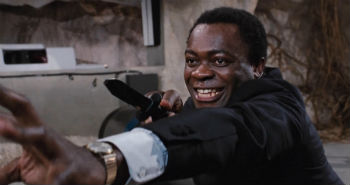 As a movie, Live and Let Die is pretty indefensible. Specifically, it’s difficult to defend scenes like the one in which James Bond dares to ask a black cabbie to escort him into the cesspool that is Harlem, to which his cabbie responds, wearing the best shit-eating grin imaginable: “Man, for twenty bucks, I take you to a Ku Klux Klan cookout!” Or the way the movie conflates America’s drug problem with cockamamie Caribbean hoodoo-voodoo, with learned black man Dr. Kanaga (Yaphet Kotto) the root of all evil. Or the way Afro wigs, soul music, jive talkin’, and a white pimp-mobile are paraded before us in a bald-faced attempt to cash in on the blaxploitation trends of the time. Or how a baddie ingests a compressed bullet and rockets upwards like an out-of-control balloon before bursting in a flatulent pop. Classy, this joint ain’t. But in spite of all that, Live and Let Die exerts an irresistible charm.
As a movie, Live and Let Die is pretty indefensible. Specifically, it’s difficult to defend scenes like the one in which James Bond dares to ask a black cabbie to escort him into the cesspool that is Harlem, to which his cabbie responds, wearing the best shit-eating grin imaginable: “Man, for twenty bucks, I take you to a Ku Klux Klan cookout!” Or the way the movie conflates America’s drug problem with cockamamie Caribbean hoodoo-voodoo, with learned black man Dr. Kanaga (Yaphet Kotto) the root of all evil. Or the way Afro wigs, soul music, jive talkin’, and a white pimp-mobile are paraded before us in a bald-faced attempt to cash in on the blaxploitation trends of the time. Or how a baddie ingests a compressed bullet and rockets upwards like an out-of-control balloon before bursting in a flatulent pop. Classy, this joint ain’t. But in spite of all that, Live and Let Die exerts an irresistible charm.
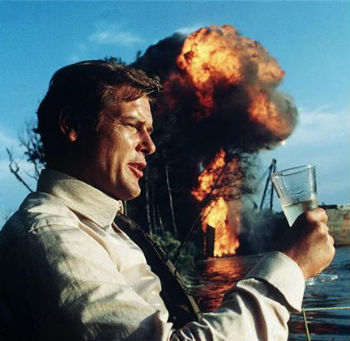 Of course, there’s little that’s classy about Ian Fleming’s Live and Let Die, either. The second book in the Bond series is a big hunk of pulp — just try to read some of that embarrassing African-American patois without wincing — that nevertheless stands up as one of the tighter Bond adventures, as our man traverses the U.S. east coast on the trail of a black criminal organization that’s teamed up with the Soviets. The novel contains some of Fleming’s best set-pieces, including the ghastly sight of Bond’s buddy Felix Leiter maimed by a shark (“He disagreed with something that ate him”) and an excruciating torture by keel-hauling (“Leave their legs free. They’ll make appetizing bait”). Curiously, the film neglects to use any of this rich material (although it would show up in later films). Instead, screenwriter Tom Mankiewicz, playing the humor card for all it’s worth, delights in incongruities: the sight of the very English Bond invading a Harlem juke joint, Kanaga concealing his identity under the guise of “Mr. Big,” your stereotypical thuggish inner-city gangster (sly commentary, actually); an American agent murdered during a New Orleans funeral procession and packed away in a coffin; action scenes where a double-decker bus and an airplane are decapitated, and a boat chase wherein the pursuers end up in swimming pools or crashing into wedding tents. The film is packed with incidents and slapstick, floating from one gag to the next, with nary a plot in sight.
Of course, there’s little that’s classy about Ian Fleming’s Live and Let Die, either. The second book in the Bond series is a big hunk of pulp — just try to read some of that embarrassing African-American patois without wincing — that nevertheless stands up as one of the tighter Bond adventures, as our man traverses the U.S. east coast on the trail of a black criminal organization that’s teamed up with the Soviets. The novel contains some of Fleming’s best set-pieces, including the ghastly sight of Bond’s buddy Felix Leiter maimed by a shark (“He disagreed with something that ate him”) and an excruciating torture by keel-hauling (“Leave their legs free. They’ll make appetizing bait”). Curiously, the film neglects to use any of this rich material (although it would show up in later films). Instead, screenwriter Tom Mankiewicz, playing the humor card for all it’s worth, delights in incongruities: the sight of the very English Bond invading a Harlem juke joint, Kanaga concealing his identity under the guise of “Mr. Big,” your stereotypical thuggish inner-city gangster (sly commentary, actually); an American agent murdered during a New Orleans funeral procession and packed away in a coffin; action scenes where a double-decker bus and an airplane are decapitated, and a boat chase wherein the pursuers end up in swimming pools or crashing into wedding tents. The film is packed with incidents and slapstick, floating from one gag to the next, with nary a plot in sight.
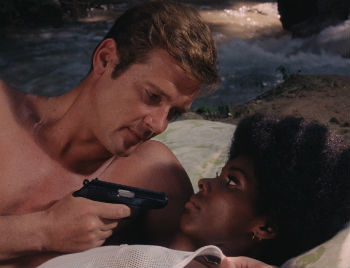 You can’t blame the filmmakers for being a bit distracted though, because Live and Let Die marks the launch of Roger Moore in the role of 007. After the lukewarm reception of George Lazenby in On Her Majesty’s Secret Service, no chances were taken. No more neophytes in the role of Bond, but an experienced thespian who had already proven he could pull audiences with TV series like The Saint and The Persuaders. Much press was generated trumpeting Moore’s resemblance to Fleming’s creation: the type smart enough to go to University and restless enough to drop out, a man of snobbish tastes and polished exterior. In order to avoid direct comparisons to Connery, Bond’s usual character tics would give way to new ones (bourbon instead of vodka martinis, Cuban cigars instead of Morland cigarettes). Setting aside Moore’s perceived strengths and shortcomings as an actor, he had an established screen persona — unruffled, twinkly, self-effacing — that would mark him as quite a different Bond, and the filmmakers would play up these differences to the hilt. While Connery might slug his way out of that Harlem bar, Moore cocks his eyebrows and tosses a few quips. Connery would woo the virginal Solitaire (Jane Seymour) into bed with pure sexual magnetism; Moore makes do with charm and a deck of stacked cards. Which is not to say that he plays Bond as an effete sissy — take the moment in which Bond sticks his gun in the face of traitorous Rosie (Gloria Hendry) after the two of them have bedded down. “You couldn’t, not after what we just did,” she protests. “You don’t think I’d do it before, do you?” Moore retorts. This is a Bond who wears his cynicism like armor, who has seen too much to bother giving a fig about anything any more. In later movies that cynicism would curdle into self-parody, but given the eccentric settings of Live and Let Die — a Caribbean poppy field guarded by Voodoo scarecrows, a Bayou infested with alligators, a broken-down back alley in New York — Moore’s bemused sarcasm fits right in.
You can’t blame the filmmakers for being a bit distracted though, because Live and Let Die marks the launch of Roger Moore in the role of 007. After the lukewarm reception of George Lazenby in On Her Majesty’s Secret Service, no chances were taken. No more neophytes in the role of Bond, but an experienced thespian who had already proven he could pull audiences with TV series like The Saint and The Persuaders. Much press was generated trumpeting Moore’s resemblance to Fleming’s creation: the type smart enough to go to University and restless enough to drop out, a man of snobbish tastes and polished exterior. In order to avoid direct comparisons to Connery, Bond’s usual character tics would give way to new ones (bourbon instead of vodka martinis, Cuban cigars instead of Morland cigarettes). Setting aside Moore’s perceived strengths and shortcomings as an actor, he had an established screen persona — unruffled, twinkly, self-effacing — that would mark him as quite a different Bond, and the filmmakers would play up these differences to the hilt. While Connery might slug his way out of that Harlem bar, Moore cocks his eyebrows and tosses a few quips. Connery would woo the virginal Solitaire (Jane Seymour) into bed with pure sexual magnetism; Moore makes do with charm and a deck of stacked cards. Which is not to say that he plays Bond as an effete sissy — take the moment in which Bond sticks his gun in the face of traitorous Rosie (Gloria Hendry) after the two of them have bedded down. “You couldn’t, not after what we just did,” she protests. “You don’t think I’d do it before, do you?” Moore retorts. This is a Bond who wears his cynicism like armor, who has seen too much to bother giving a fig about anything any more. In later movies that cynicism would curdle into self-parody, but given the eccentric settings of Live and Let Die — a Caribbean poppy field guarded by Voodoo scarecrows, a Bayou infested with alligators, a broken-down back alley in New York — Moore’s bemused sarcasm fits right in.
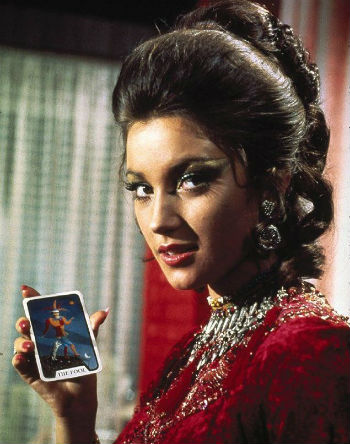 Returning for his third Bond film, director Guy Hamilton provides more punch to the proceedings than he did in Diamonds Are Forever. Solitaire’s psychic abilities with Tarot cards, underplayed in the novel, get a full workout in the film, culminating in a scene in which Kanaga exposes her perfidy, a DEATH card upturned at a crucial moment — rarely do we get a scene between a Bond villain and his mistress that drips with as much dramatic tension. Then there’s the cliffhanger at Kanaga’s alligator farm, Bond surrounded on all sides by the hungry reptiles, capped by a dazzling stunt for his getaway (performed, ironically enough, by a real-life alligator farmer named Kanaga). Whatever you think of the blaxploitation backdrop, the movie gets some decent comic mileage out of contrasting Moore’s aristocratic Bond with the hepcats around him — 007 is most definitely less hip than usual, which humanizes him a bit. The film is also more vibrant than most 007 flicks, boosted by a ballsy score by Beatles producer George Martin (and of course the classic title theme by Paul McCartney). And just in case you find yourself missing some of the thrills of an old-time Bond film, we get a tussle on-board a train between Bond and the claw-handed henchman Tee-hee (a grinning Julius Harris) that’s as entertaining as any scuffle from the series.
Returning for his third Bond film, director Guy Hamilton provides more punch to the proceedings than he did in Diamonds Are Forever. Solitaire’s psychic abilities with Tarot cards, underplayed in the novel, get a full workout in the film, culminating in a scene in which Kanaga exposes her perfidy, a DEATH card upturned at a crucial moment — rarely do we get a scene between a Bond villain and his mistress that drips with as much dramatic tension. Then there’s the cliffhanger at Kanaga’s alligator farm, Bond surrounded on all sides by the hungry reptiles, capped by a dazzling stunt for his getaway (performed, ironically enough, by a real-life alligator farmer named Kanaga). Whatever you think of the blaxploitation backdrop, the movie gets some decent comic mileage out of contrasting Moore’s aristocratic Bond with the hepcats around him — 007 is most definitely less hip than usual, which humanizes him a bit. The film is also more vibrant than most 007 flicks, boosted by a ballsy score by Beatles producer George Martin (and of course the classic title theme by Paul McCartney). And just in case you find yourself missing some of the thrills of an old-time Bond film, we get a tussle on-board a train between Bond and the claw-handed henchman Tee-hee (a grinning Julius Harris) that’s as entertaining as any scuffle from the series.
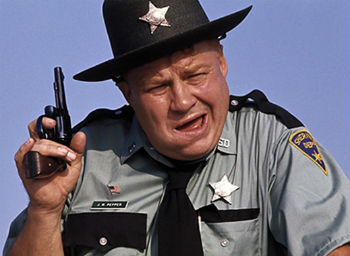 Make no mistake though, Live and Let Die is a mixed bag. Just about every bit of seriousness is countered with a good dose of silliness. In addition to the aforementioned blow-up baddie and the farcical action scenes, there’s Louisiana hick sheriff J.W. Pepper (Clifton James). Spitting tobacco, forever a few steps behind Bond and his enemies, and generally fulfilling every cliche one might have about an American South that still features license plate stickers like Lee surrendered but I did not, Pepper is this film’s idea of equal opportunity (See? We can make fun of white people too). Danger still lurks at the corners of the movie, but J.W.’s presence and the proliferation of repercussion-free hijinks mark a changing of the guard. Where Bond films used to be thrillers, Live and Let Die is an unapologetic amusement park machine: a few moments of whee, a lot of sugary cotton candy, and by the end you’ll leave with a grin and little memory of what happened.
Make no mistake though, Live and Let Die is a mixed bag. Just about every bit of seriousness is countered with a good dose of silliness. In addition to the aforementioned blow-up baddie and the farcical action scenes, there’s Louisiana hick sheriff J.W. Pepper (Clifton James). Spitting tobacco, forever a few steps behind Bond and his enemies, and generally fulfilling every cliche one might have about an American South that still features license plate stickers like Lee surrendered but I did not, Pepper is this film’s idea of equal opportunity (See? We can make fun of white people too). Danger still lurks at the corners of the movie, but J.W.’s presence and the proliferation of repercussion-free hijinks mark a changing of the guard. Where Bond films used to be thrillers, Live and Let Die is an unapologetic amusement park machine: a few moments of whee, a lot of sugary cotton candy, and by the end you’ll leave with a grin and little memory of what happened.
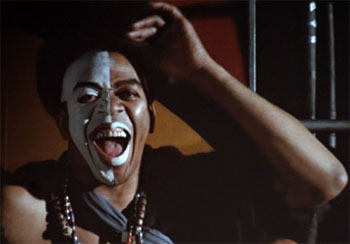 Fortunately, Hamilton gets an able assist from his actors, who all do yeoman’s work even if their characters are only sketched out. Though Solitaire is ultimately reduced to a damsel in distress (as often happens with Bond girls), Seymour is appealing in her first starring role, and Kotto gives good glower, even when his face is covered in that silly Mr. Big makeup. Making the biggest impression is Geoffrey Holder’s towering Baron Samedi — laughing his famous volcanic laugh and prancing about like a jester of the damned, we’re never sure how serious (or mortal) his character is supposed to be. That ambiguity stands out, and the final image of Holder, seemingly resurrected from death, cackling away atop a train locomotive, suggests a film that had the potential to be unpredictable as well as diverting. As it is, Live and Let Die is a Bond film that is no longer interested in being hip, and just tries to have fun — and fun it is, as fatuous as it gets at times.
Fortunately, Hamilton gets an able assist from his actors, who all do yeoman’s work even if their characters are only sketched out. Though Solitaire is ultimately reduced to a damsel in distress (as often happens with Bond girls), Seymour is appealing in her first starring role, and Kotto gives good glower, even when his face is covered in that silly Mr. Big makeup. Making the biggest impression is Geoffrey Holder’s towering Baron Samedi — laughing his famous volcanic laugh and prancing about like a jester of the damned, we’re never sure how serious (or mortal) his character is supposed to be. That ambiguity stands out, and the final image of Holder, seemingly resurrected from death, cackling away atop a train locomotive, suggests a film that had the potential to be unpredictable as well as diverting. As it is, Live and Let Die is a Bond film that is no longer interested in being hip, and just tries to have fun — and fun it is, as fatuous as it gets at times.

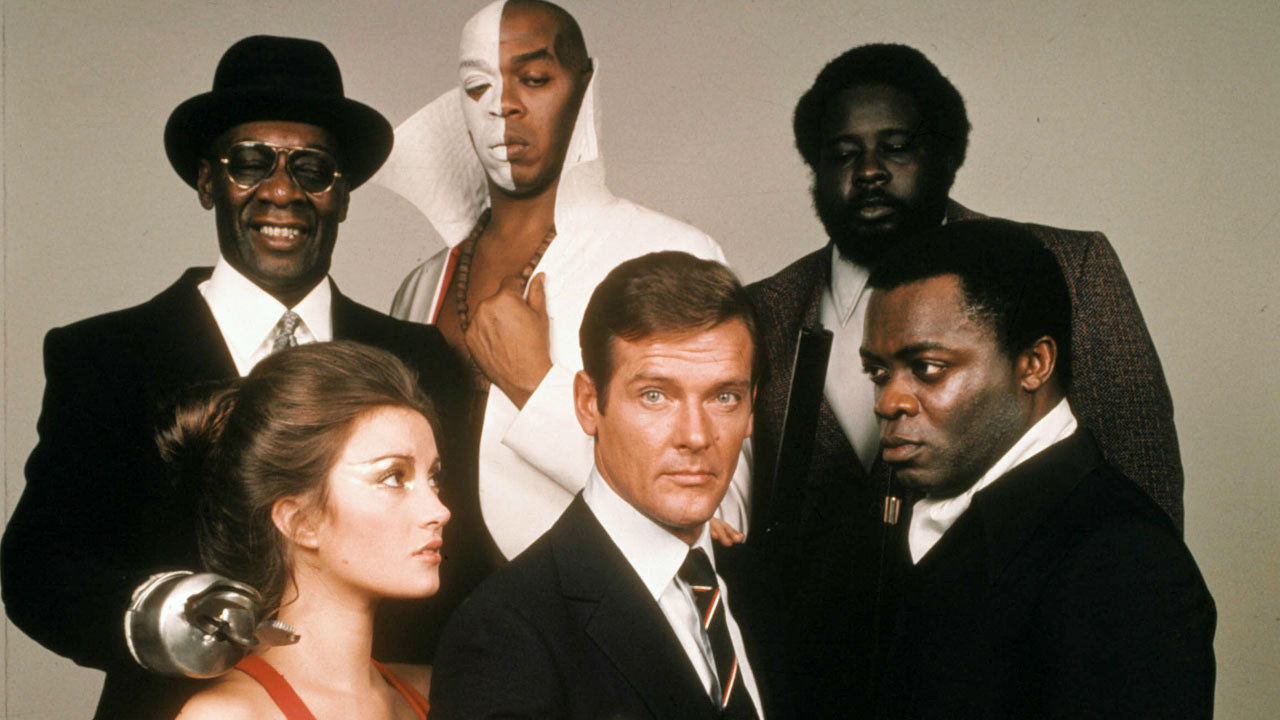
Comments
David Saia
Hey Ho, Just watched this today and read your review. Well written as they all are. I also finished watching MWTGG -- and will read your […] Read MoreHey Ho, Just watched this today and read your review. Well written as they all are. I also finished watching MWTGG -- and will read your review of that one too. Read Less